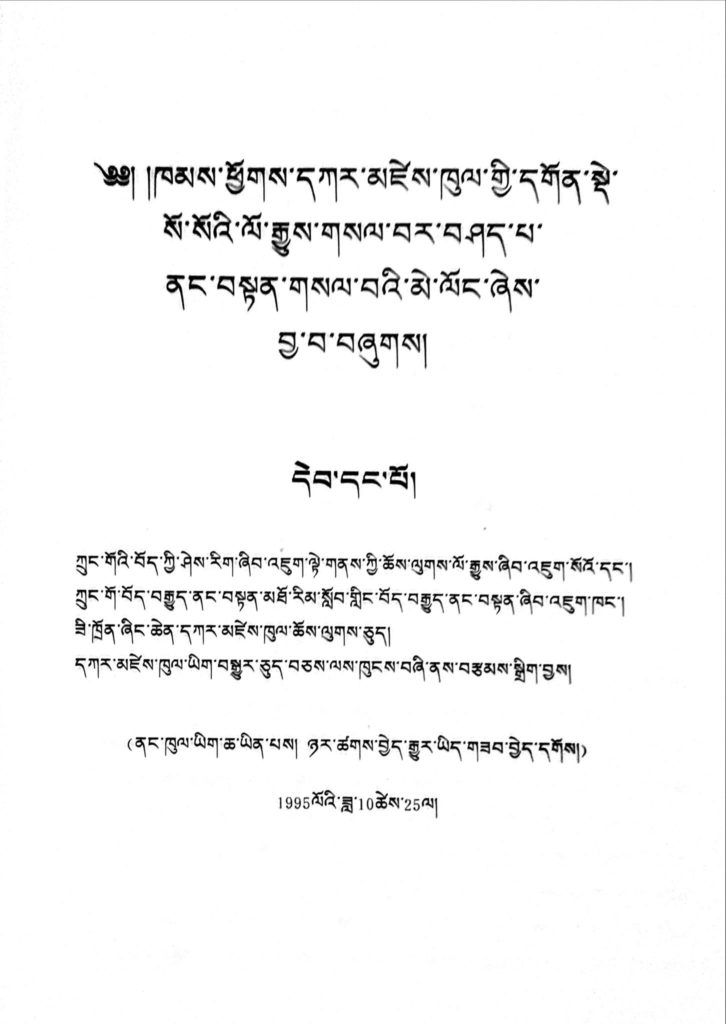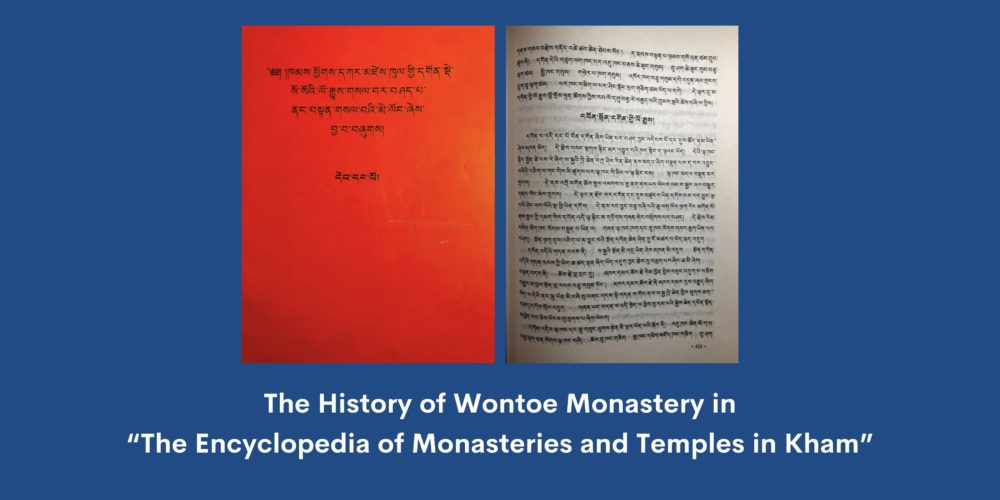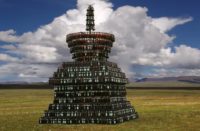 High Peaks Pure Earth presents an English translation of the entry for Wontoe Monastery in “The Encyclopedia of Monasteries and Temples in Kham, Kardze”, a rare three volume set that was published in Tibet in 1995. Only 300 copies of this set was printed and on the above page it states that the encyclopedia is for “internal purposes” only meaning it was only for official use and not for larger public circulation.
High Peaks Pure Earth presents an English translation of the entry for Wontoe Monastery in “The Encyclopedia of Monasteries and Temples in Kham, Kardze”, a rare three volume set that was published in Tibet in 1995. Only 300 copies of this set was printed and on the above page it states that the encyclopedia is for “internal purposes” only meaning it was only for official use and not for larger public circulation.
Recently Wontoe Monastery (Tibetan: དབོན་སྟོད་དགོན། Wylie: dBon stod dgon) has come under the spotlight as it is located in an area of Kham threatened by the construction of the Kamtok (Ch: Gangtuo) hydroelectric dam on the Drichu River (Ch: Jinsha) which straddles Jomda County on the Tibet Autonomous Region side and Dege County on the Kardze Prefecture side. The impending construction threatens to submerge Wontoe Monastery, situated in Wontoe Township, an historical site, erasing not only physical structures but also wiping away the priceless murals.
The villagers, monks and laypeople have united in a collective voice against the dam, staging protests. The level of public participation is unprecedented, drawing attention to a cause that extends beyond environmental concerns. Wontoe Monastery would be one crucial casualty of the dam and is an architectural gem that has stood as a testament to the region’s rich cultural history since the 14th century. The intricate murals adorning the monastery walls not only showcase artistic brilliance but also narrate the story of the monastery’s evolution through the ages.
The murals have become subject of scholarly interest, with Chinese scholar Yao Ruiyi from the Chinese Academy of Social Sciences presenting her study of the murals at the 8th International Academic Symposium on Tibetan Archaeology and Art in Hangzhou in December 2023. In 2018, the government of Kardze Tibetan Prefecture showcased the murals on their website, emphasizing the global significance of this cultural heritage.
As writer and commentator Tsering Woeser has said,
“[…] Wontoe and Yena Monasteries belong to the Sakya sect of Tibetan Buddhism, and they have a long history and survived the “Cultural Revolution.” Ancient architecture styles and murals from them have precious historical and artistic values and have attracted the attention of researchers from all walks of life in recent years. A group of murals from the 14th to 15th centuries are considered “one of the most important Tibetan Buddhist murals discovered locally so far, and have high reference value for the study of Tibetan painting art.” However, now due to the construction of hydropower station, monasteries and villages are facing the fate of being submerged. Researchers also pointed out the critical situation, “The hydropower station will cause greater difficulties in the subsequent preservation and research of the murals in Wontoe Monastery. The research and protection of these murals in the monastery is urgent.” (Translation by International Campaign for Tibet)
However, uncovering the details and unraveling the history of Wontoe Monastery has proven to be a daunting challenge. There is very little known about the monastery and this is only written account we were able to find. According to the entry, a lDan rabs (history of the monstery) exists but it has not been found.
We would like to thank Tenzin Gelek, New York, for the valuable translation of the encyclopedia entry. In the coming days we will post more translations about the situation in Dege and its rich cultural heritage.
The History of Wontoe Monastery in “The Encyclopedia of Monasteries and Temples in Kham”
Originally, this monastery was believed to be a Bonpo monastery. However, information about the founder has yet to be discovered. Later, it was converted into the Nyingma tradition, and its legacies are still visible.
According to accounts, the temple was in great decay, and it was Tashi Rinchen, the Sakya Trichen, (1824-1865) who shot an arrow at the monastery. This act was believed to protect the monastery from natural disasters, and as a result, the temple was named Lhanying (ལྷ་རྙིང), which means The Ancient Temple or the Temple pierced by an arrow.
Subsequently, Drogon Chogyal Pakpa (1235-1280), during his journey back to Tibet from China, converted the monastery into the Sakya tradition. If the historical records are correct, this would mean that the monastery dates back to a similar time as Dzongsar Monastery, around the Tibetan Wood-Pig Year of the 5th Rabjung Cycle (1275-1276).
In the Tibetan Water-Pig year of the 14th Rabjung Cycle (1863-1864), the army of Nyakrong Gonpo Tashi (1799-1865) destroyed much of the monastery, burning everything to the ground apart from the Lhanying temple. Despite this devastation, the monastery was gradually restored, with the roof temple and other structures, including the temples and monk quarters, being rebuilt by the local people. It is said that this great monastery was a magnificent sight before the destruction caused by Nyakrong Gonpo Tashi.
The Lines of the Throne Holder of the Monastery
Not many people know the monastery’s history before the Sakya occupied the place. Historical accounts of the monastery existed; however, the text has been lost, and we don’t have a clear knowledge of the monastery’s history.
The highest authority of the monastery is the Choje, also known as the Lord of the Dharma, who resides in the Choje Labrang. The person chosen as the Choje comes from the region’s Kharmar (mkhar dmar) clan. The Sakya Trizin from Central Tibet chose one out of four outstanding candidates. Before Chinese rule, there had been 13 Choje throne holders. Wontoe Khyenrab (1889-1960s) was the most notable scholar from Tibet; he was the Choje of Wontoe Monastery.
The monastery consisted of a large main Assembly Hall with over 100 pillars in size, four temples, a college, a spacious living quarter, a treasure house, and a monk quarter with 113 rooms. In Drolma Lhakhang, for example, there are statues of Sakya Pandita, Atisha, Maitreya Buddha, Buddha Dipankara, and a golden roof, all made of copper alloy. The 21 Taras and 16 Arhats statues are slightly smaller than the figures above.
How did this monastery fall into ruin?
During the Cultural Revolution, the Lhanying Temple and the Assembly Hall were used as commune storage facilities, sparing their structures from destruction but resulting in the loss of all their sacred and precious contents and under the current leadership of Khenpo Tsultrim Tenzin, local people and monks worked together to rebuild the temples, college, and debating yard. Currently, the monastery is home to 160 monks dedicated to preserving the practices and rituals of the past.





Follow Us!